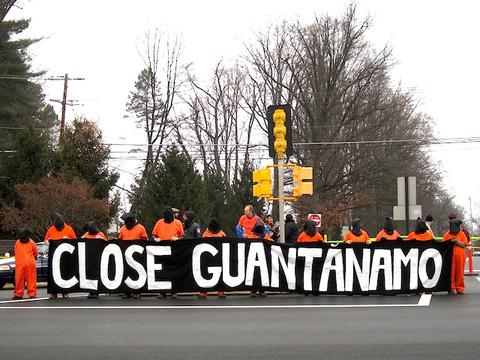Guantánamo Authorities Respond to Hunger Strike with Violence; Red Cross Complains

Campaigners from Witness Against Torture call for the closure of Guantánamo at a protest against torture, indefinite detention and the use of drones, outside the entrance to CIA headquarters, January 13, 2013. Photo by Andy Worthington, via Flickr.
By Andy Worthington, April 22, 2013
In response to the prison-wide hunger strike at Guantánamo, the authorities last weekend stormed into Camp 6, the block where the majority of the prisoners are held, and hauled most of the prisoners off to solitary confinement.
The authorities attempted to justify their actions -- but failed to understand that the men who are endangering their lives by embarking on a hunger strike, are doing so not to upset the authorities for no reason, or to challenge their authority needlessly, but because they despair of ever being released.
Even though 86 of the 166 men still held were cleared for release by an inter-agency Guantánamo Review Task Force established by President Obama in 2009, the U.S. government has turned its back on them. Although two-thirds of the cleared prisoners are Yemenis, President Obama issued a blanket ban on releasing any Yemenis after the failed underwear bomb plot on Christmas Day 2009 (perpetrated by a Nigerian man recruited in Yemen).
Congress has also raised obstacles preventing the release of prisoners, and the court of appeals in Washington D.C. -- the D.C. Circuit Court -- has also issued rulings preventing the release of prisoners for reasons that have much more to do with ideology and paranoia than with the facts.
The men are effectively stranded at Guantánamo, and will die there unless action is taken immediately by President Obama to bring this intolerable situation to an end.
Instead, however, Obama has said nothing, and has left it to military officials to attempt to airbrush the prisoners' profound grievances out of existence, portraying the hunger strike as a question of restoring order against a hostile force.
As the New York Times explained last Wednesday, after a briefing at Guantánamo for a handful of media organizations (following a ban on reporters' visits for several weeks), military officials described conditions in the prison in the weeks leading up to the raid as "chaotic, with detainees breaking rules with impunity, blocking cameras and windows, shouting at guards, splashing them with urine and poking sticks at them through the fencing. They said prisoners refused to go into their cells and shut their doors for a daily two-hour lockdown, and it was deemed too dangerous for guards to enter the common area to remove a troublemaker when many prisoners were freely roaming."
The officials told the Times that the pre-dawn raid on April 13, on Camp 6 -- where the majority of the prisoners had been living in relative freedom, allowed most of the time to mingle in the block's communal areas -- "was an effort by guards to force prisoners living in communal housing to move to individual cells." The raid, they said, began at 5:10 a.m. and lasted about five hours, and only began after representatives of the International Committee of the Red Cross had finished visiting. That was dressed up as coincidental, although it was clearly no such thing.
Moving vulnerable men who are in despair about their plight to solitary confinement is particularly cruel, although the Times failed to mention this. Instead, it was noted that the officials said that, "in its early stages, detainees wielding broomsticks hit two guards on their helmets during a brief melee that resulted in injuries to five detainees." They added, however, that "the majority of the detainees did not offer any resistance, going to their cells as instructed or lying in the common area to be handcuffed." Rear Adm. John W. Smith Jr., the commander of the Guantánamo Joint Task Force, specifically said that he had ordered the raid "because guards could not see into the facility to ensure the safety of the detainees."
That, however, is a poor cover story for what, in reality, was obviously a dispute about order and control.
The military showed reporters around Camp 6, where, as the Times noted, the prisoners were "now under lockdown." During the tour, prison guards "could be seen sitting at metal tables in the common areas and walking the two-tiered cell blocks, peering into the closed cells." In addition, "In a central control room, guards watched monitors showing several dozen detainees inside their cells." Officials explained that, prior to the raid, the prisoners "had covered up 147 out of 160 surveillance cameras," although no video or photographic evidence was provided, and Adm. Smith said that no filming had taken place.
Col. John Bogdan, the commander of Joint Task Force Guantánamo's Detention Group -- blamed by the prisoners for starting the hunger strike through aggressive cell searches and abusive treatment of the prisoners' Korans -- told the press that the guards had "trained for the raid for three weeks." According to this account, the prisoners, armed with "about two dozen metal sticks and wooden staffs taken from brooms and mops, a metal bar taken from exercise equipment, and long staffs made from crushed bottles wrapped in tape," fought with guards, leading to two guards being hit and four non-lethal rounds being shot by the guards. What was not explained was how the prisoners were supposed to have been able to gather so many sticks and staffs without anyone noticing.
Capt. Richard Stoltz, the commander of the prison medical group, said that the two guards were not hurt. Of the prisoners, one "was hit with rubber pellets in his 'left flank,' and two of them were later removed from his skin." Three others "had minor injuries to their forearm, chest and elbow." A fifth prisoner, alarmingly, "began banging his own head into the wall of his cell, and he was treated with three sutures."
He was not the only prisoner driven to self-harm. The officials stated that two others "tried to commit suicide by hanging themselves" -- one on the night before the raid, and the other after it.
Here at "Close Guantánamo," we remain deeply concerned that the Obama administration has done nothing to resolve the hunger strike without violence, and has done nothing to free any of the 86 men cleared for release, even though the hunger strike has now been underway for two and half months.
We share the concerns aired by Navi Pillay, the United Nations Human Rights Commissioner, and also the complaints aired on April 11 by Peter Maurer, the President of the International Committee of the Red Cross, the prison visitors whose access to the majority of prisoners worldwide is supposed to be dependent on their discretion.
Throughout the Bush administration, senior Red Cross figures occasionally broke with protocol and openly criticized the administration, as in October 2003, when Christophe Girod, the head of the office in Washington D.C., said, "The open-endedness of the situation and its impact on the mental health of the population has become a major problem."
To date, however, President Obama has avoided serious censure, although it is now well-deserved, as he now thoroughly owns Guantánamo, and has thoroughly abandoned the men still held there.
As Reuters described it, Peter Maurer "expressed opposition to the force-feeding of prisoners staging a mass hunger strike at the Guantánamo prison camp and said he urged U.S. President Barack Obama to do more to resolve the 'untenable' legal plight of inmates held there."
Maurer "made his case in talks with Obama and other top U.S. officials in Washington," while a team of ICRC representatives was in Guantánamo, and his words were clearly meant to shake President Obama out of his torpor regarding Guantánamo.
As Reuters proceeded to explain, he said at a press conference that the hunger strike "was a 'symptom' of the prisoners' legal plight," and explained, "The issue of Guantánamo is politically blocked in this country." He also said that his message to President Obama and his advisers was that "they should put all their energy" into reaching a solution regarding Guantánamo.
Maurer also "said he had pressed Obama, senior administration officials and U.S. lawmakers to work harder to address the Guantánamo prisoners' legal predicament," adding that "the main issues include delays in promised regular reviews of prisoners' cases and hold-ups in transfer to their home countries of those deemed no longer a security risk."
These remain key demands for everyone concerned with closing Guantánamo, echoing complaints we have long made here at "Close Guantánamo," and which we formalized in February, and have reiterated many times since.
See below for details of how you can get involved:
- Contact President Obama
Contact the White House and tell President Obama, "Please release the 86 prisoners cleared for release by your inter-agency task force, and initiative objective reviews for the 46 others that you designated for indefinite detention without charge or trial in an executive order two years ago." Call 202-456-1111 or submit a comment online. Please also tell President Obama, "Please appoint a White House official to direct the closure of Guantánamo, and direct the Secretary of Defense to use his authority under the law to release men who will not be charged. Please also lift your own blanket ban on sending home the cleared Yemeni prisoners.”
- Contact Chuck Hagel
Contact Secretary of Defense Chuck Hagel and tell him, "Please use your authority under the law to resume transferring the 86 men cleared for release by President Obama's inter-agency task force. The National Defense Authorization Act (NDAA 2013) gives you the authority to certify men or issue waivers so they can be released from Guantánamo, and you must use this authority without further delay." Call Secretary Hagel at the Department of Defense on 703-571-3343 or submit a comment online.




